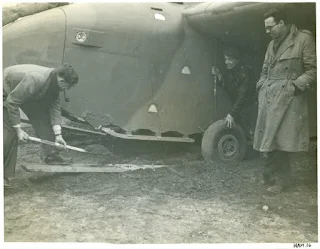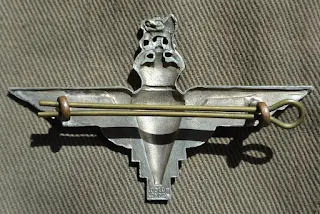Although the WWII Airspeed AS.51 Horsa assault glider was the most prolific of the allied glider aircraft which augmented the parachute elements of the British 1st and 6th Airborne Divisions it remained for another glider, the General Aircraft GAL 49/50 Hamilcar, to deliver the heavier loads which would provide extra muscle to the lightly armed paratroops and airlanding forces. It was the heaviest of allied gliders and the only one capable of carrying a tank.
More importantly for the airborne forces it was capable of carrying the Ordnance QF 17 pdr Anti-tank Gun, its Morris C.8/AT 30cwt Quad Field Artillery Tractor (FAT), basic ammunition load, and complete gun crew from an Airlanding Anti-tank Battery, Royal Artillery, all in a single load. This capability provided a rather nasty surprise to the most heavily armored German tanks, even the Tiger I (max. frontal armor, 100 mm). The gun was capable of penetrating 118 mm of armor plate at 1000 yd, and with the introduction in July 1944 of an Armor Piercing, Discarding Sabot (APDS) round, 231 mm (9.1 in.) of armor plate at 1000 yd. (more than enough to 'put paid' to even the Tiger II).
More importantly for the airborne forces it was capable of carrying the Ordnance QF 17 pdr Anti-tank Gun, its Morris C.8/AT 30cwt Quad Field Artillery Tractor (FAT), basic ammunition load, and complete gun crew from an Airlanding Anti-tank Battery, Royal Artillery, all in a single load. This capability provided a rather nasty surprise to the most heavily armored German tanks, even the Tiger I (max. frontal armor, 100 mm). The gun was capable of penetrating 118 mm of armor plate at 1000 yd, and with the introduction in July 1944 of an Armor Piercing, Discarding Sabot (APDS) round, 231 mm (9.1 in.) of armor plate at 1000 yd. (more than enough to 'put paid' to even the Tiger II).
The first prototype (GAL 49) flew on 27 March 1942. A total of either 344 or 410 (depending on sources) Hamilcars had been built when production ended in 1946, at a cost of £50,000 per glider. As was the case with the design of the Horsa, construction of the Hamilcar was almost entirely of wood, taking full advantage of Britain's 'cottage industry', aluminum being in short supply. (Most of the images can be enlarged by clicking on them.)
 |
| A contemporary detailed cut-away drawing of the prototype General Aircraft GAL 49 Hamilcar I Glider with acknowledgment to Creative Cutaways and The Aeroplane Spotter |
 |
| A later equally detailed cut-away drawing of the GAL 49 Hamilcar Glider showing a Tetrarch Mk VII ICS Tank as carried with acknowledgment to Flight Magazine |
 |
| Annotated detailed cut-away drawing of the cargo box of the General Aircraft GAL 49 Hamilcar Glider |
 |
| A scaled 3-view of the General Aircraft GAL 49 Hamilcar Glider (Color of lower fuselage should be matte black) |
The relatively clean aerodynamic shape of this WWII assault glider seen at a distance belies the size of this leviathan. With a wingspan of 110 ft (33.53 m) and length of 68 ft (20.73 m) it was only slightly larger than the Horsa, but its cargo box was significantly more voluminous, accommodating over twice the payload. The Hamilcar glider’s empty weight was 18,400 lb (8,346 kg) with a maximum takeoff weight of 36,000 lb (16,329 kg) (7 tons of cargo), as compared with the Horsa’s weight of 8,370 lb (3,804 kg) and maximum takeoff weight of 15,500 lb (7,045 kg).
 |
| The General Aircraft GAL 49 Hamilcar Heavy Assault Glider at a distance very deceptive in size |
The following are selected pages from the Pilot's Notes for the HAMILCAR MK I Glider, A.P. 2219-A P.N. 2nd Edition, October 1944, showing detailed drawings of the cockpit of the glider, with annotations.
The Hamilcar was cleared and capable of carrying any one of the following payloads:
The Hamilcar was cleared and capable of carrying any one of the following payloads:
1 Tetrarch Mk VII ICS (infantry close support) light tank (15,680 lb)
1 US Locust M22 light tank (16,400 lb)
2 Universal (Bren) Carriers (17,000 lb)
3 Rota Tank trailers with 4 Airborne supply panniers
1 Mortar carrier (9,280 lb) with 8 motorcycles (2,880 lb)
1 17 pdr Anti-tank gun (4,624 lb) with modified Morris C.8/AT 30cwt
Quad Tractor (empty weight 7,496 lb (3,400 kg), prime mover)
Quad Tractor (empty weight 7,496 lb (3,400 kg), prime mover)
1 25 pdr Field gun with modified tractor
2 Daimler Armored Scout cars
1 D4 Small Bulldozer (15,920 lb)
1 Universal (Slave battery) Carrier with 1 Jeep
48 Airborne supply panniers for equipment and ammunition
1 Scraper with equipment plus 1 Fordson tractor for pulling scraper
1 Grader with 9 Airborne supply panniers
1 40mm Bofors Antiaircraft gun (Self-propelled)
Bailey pontoon bridging equipment
1 HD10 or HD14 bulldozer (in three Hamilcars)
 |
| Load test showing a Universal (Bren) Carrier emerging from the Hamilcar Glider |
 |
| Another load test showing an American Locust M22 Light Tank |
 |
| The Locust M22 Light Tank, with tank crew in flight positions, and tank properly chocked and shackled in the glider |
 |
| The Tetrarch Mk VII ICS Light Tank being disembarked from the Hamilcar glider during load qualification trials |
 |
| Field Marshal Montgomery observing the loading trials of the Tetrarch Mk VII ICS Light Tank in a Hamilcar glider |
 |
| A Morris C.8/AT 30 cwt Quad Field Artillery Tractor (FAT) in unmodified configuration, for glider flight it would be stripped of its canvas top and framing |
 |
| Rear view of the Ordnance QF 17 pdr Anti-tank Gun a massive artillery piece (weight in action, 4,624 lb) |
 |
| The 'business end', i.e. muzzle, of the 17 pdr Anti-tank Gun |
 |
| Close-up side view of a pair of 17 pdr Anti-tank Guns |
 |
| A group of three 17 pdr Anti-tank rounds; the one on the left being the Armor Piercing Discarding Sabot (APDS) configuration |
Only the heavy bombers of the Royal Air Force were capable of towing a fully loaded Hamilcar glider. These included the Sterling, Lancaster or Halifax bombers. Towing speed was 150 mph (240 km/h) and the normal approach speed was 100 mph (130 km/h), with maximum never exceed diving speed of 187 mph (300 km/h).
Hamilcar gliders participated in Operation Tonga (in support of the D-Day invasion of Normandy, Operation Overlord), Operation Market-Garden (Arnhem) and Operation Varsity (Crossing of the Rhine). They were principally flown by personnel of the Glider Pilot Regiment, Army Air Corps (AAC). The Tetrarch tanks were manned by the 6th Airborne Armoured Reconnaissance Regiment, Royal Armoured Corps. An excellent book about this unit, as well as the Hamilcar and Tetrarch is; Airborne ARMOUR, K. Flint, Helion & Co., Ltd., Solihull West Midlands, 2004, ISBN 1 874622 37 X.
 |
| Detailed multi-view of the Tetrarch Mk VII ICS Light Tank showing all tactical signs |
 |
| Side elevation and top plan view of the Tetrarch Mk VII ICS Light Tank |
With special thanks and acknowledgment to Howard J. Curtis, the following photograph was taken of a display at the National Tank Museum, Bovington, UK, of one of the few remaining Tetrarch Mk VII ICS light tanks, within the partial fuselage of a Hamilcar glider (note the glider's cockpit up and behind the tank).
 |
| Tetrarch Mk VII ICS Light Tank shown in its storage position on the forward cargo deck of the remains of a fuselage from a General Aircraft GAL 50 Hamilcar I Glider. |
 |
| Another view of the same tank showing the close clearance of the treads to the edges of the cargo deck |
 |
| Again the same Tetrarch Mk VII but slightly off angle, and showing Hamilcar cockpit above and aft |
 |
| This image shows the foremost bulkhead of the Hamilcar fuselage where the nose section was hinged |
The most intact remaining example of a Hamilcar Glider can be found at the Museum of Army Flying, Middle Wallop, Hampshire, UK. Our sincere thanks and acknowledgment to Peter Clarke for this great photograph of the display. To give you a better appreciation of size note the mannequin of a glider pilot up by the rear cockpit seat.
For more details regarding the General Aircraft GAL 49/50 Hamilcar glider, its development and operational use see; http://en.wikipedia.org/wiki/General_Aircraft_Hamilcar, and the Para Data link of the Parachute Regiment and Airborne Forces Museum, Duxford listed on this blog.
Portions of the following contemporary newsreel footage are included on other pages of this blog. Thought however they should be also incorporated on this page in order to provide continuity and completeness. It is listed here as a link as it can't be directly integrated, apparently due to copyright issues. The link is; https://www.youtube.com/watch?v=EHo3pSmknHY
Following are two fairly obscure photographs of a piloted 1:2 scale "proof of concept" model built by General Aircraft, Ltd., designated the GAL 50, and used to establish the feasibility and aerodynamic characteristics of the Hamilcar glider prior to building the first full scale prototype. The photographs were probably taken sometime in 1941.
Following are two fairly obscure photographs of a piloted 1:2 scale "proof of concept" model built by General Aircraft, Ltd., designated the GAL 50, and used to establish the feasibility and aerodynamic characteristics of the Hamilcar glider prior to building the first full scale prototype. The photographs were probably taken sometime in 1941.



















